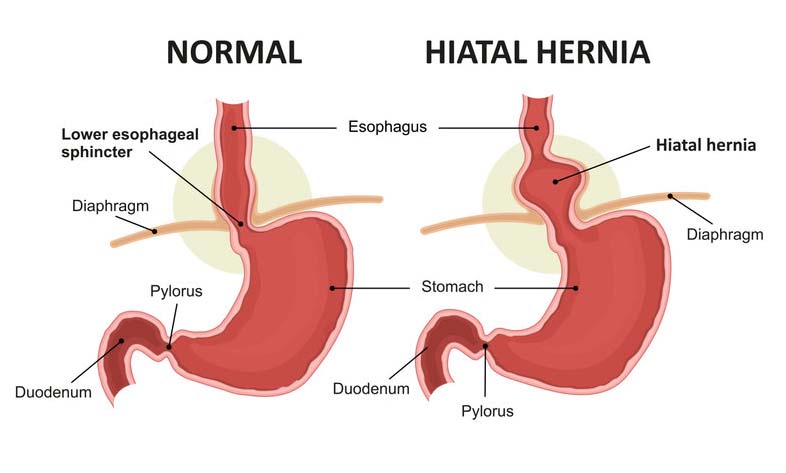
Myofascial Release Can Help Hiatal Hernia
If you’re suffering from hiatal hernia pain and have exhausted all other medical options, it’s time to explore Myofascial Release Therapy. Carolina Gutierrez is a Myofascial Release Practitioner who has helped patients with reversing hiatal hernias and go back to living a pain-free life.
What is a Hiatal Hernia?
To understand the causes of hiatal hernias, you first need to understand the anatomy involved. The core is divided into two sections: the thoracic region and the lumbar-abdominal region. They are divided by a large, fibrous, dome-shaped muscle called the diaphragm. Our main respiratory muscle attaches to the lower ribs and the lower thoracic spine.
The diaphragm has opening to allow the pass of blood vassals and organs.
- One for the aorta
- one for the vena cava
- one that concerns us today, called the hiatus, for the esophagus.
The stomach is located just below the hiatus. Surrounding all of this and everything else in the body is a type of tissue called fascia. In normal conditions, fascial is very elastic.
How Fascia Affects a Hiatal Hernia
When injured, traumatized or inflamed, the fascia becomes more rigid. Because fascia surrounds every organ, nerve, muscle, bone, ligament and tendon, this can cause major changes in posture and mobility of all the tissues, joints and organs. If this goes unchecked, lines of tension begin to spread across the body, usually in diagonal patterns. The diaphragm, being at the center of the body, is often affected by fascial injury almost anywhere in the body.
There is a functional relationship between the diaphragm and the pelvic floor that is not often taken into consideration. When the diaphragm contracts for a breath, it pulls downward and lowers the pressure within the chest cavity, allowing the lungs to inflate.
At the same time, the pelvic floor muscles have to pull down to maintain constant pressure within the abdominal cavity. If this does not happen, the organs within the abdomen would be compressed.
What Causes Hiatal Hernia Pain?
 When someone is complaining of hiatal hernia pain, there is usually a problem with the pelvic floor, the diaphragm does not contract fully. Because of these restrictions, it will become rigid and tight due to not continuously stretching out the fascia within and around the muscle.
When someone is complaining of hiatal hernia pain, there is usually a problem with the pelvic floor, the diaphragm does not contract fully. Because of these restrictions, it will become rigid and tight due to not continuously stretching out the fascia within and around the muscle.
If the individual has a minor trauma or inflammation within the abdominal cavity, that can cause the fascia around the organs to become stiffer and shrink. If this happens around the stomach, the fascia can pull the stomach upward toward the diaphragm and can cause the top of the stomach to begin to migrate through the hiatus into the thoracic cavity.
Now you have what amounts to a tourniquet around the top of the stomach. This will cause a slower emptying of the stomach contents into the small intestine. If the stomach cannot empty normally, it causes a backflow of the stomach contents up into the lower part of the esophagus. This backflow is known as acid reflux. This condition can cause damage to the esophagus. The early stages of a hiatal hernia is heartburn. If left unchecked, the condition will gradually progress over time.
Hiatal Hernia Treatment Options
Traditional treatment of hiatal hernias include medications to decrease the stomach acid or surgical repair. The problem with the use of medications is they don’t address the initial cause of the problem, only the symptoms. Also, reducing stomach acid will change how the digestive process occurs in the stomach and may make some foods indigestible.
Surgical repair brings the stomach back down into the abdominal cavity but causes a great deal of scar tissue and even more irritation, inflammation and trauma to the fascia, which can and often does cause recurrence of the problem.
Myofascial Release Treatment
Myofascial Release Therapy, specifically The John Barnes approach, to the diaphragm and around the stomach; visceral mobilization to physically assist the stomach to come down out of the hiatus; will induce the fascial to release tension and restrictions.
Myofascial Release Therapy will also work on the postural issues surrounding this problem, as fascial restrictions allow it, is effective to prevent recurrence as well as improve comfort.
Depending on the severity of the problem, it takes several weeks to make a positive change. However, few people have immediate relief in symptoms after the first visit. To see the joy in their eyes as they can walk out of my office pain-free is priceless.
Are you ready to live pain-free?
FREE 15 MINUTE PHONE CONSULT
Want to see if I’m a good fit for you?
Set up a FREE 15-minute phone consultation so we can chat.
No pressure. Honestly.